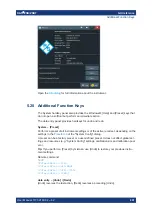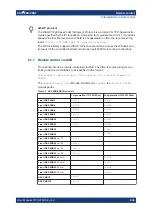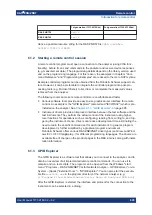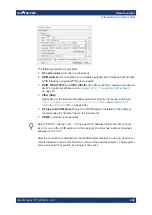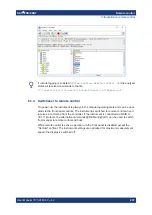
Remote control
R&S
®
ZNB/ZNBT
812
User Manual 1173.9163.02 ─ 62
SCPI compatibility
The analyzers are compatible to the final SCPI version 1999.0. Not all the commands
supported by the instrument are taken from the SCPI standard (Standard Commands
for Programmable Instruments), however, their syntax follows SCPI rules. The SCPI
standard is based on standard IEEE 488.2 and aims at the standardization of instru-
ment-control commands, error handling and the status registers.
The requirements that the SCPI standard places on command syntax, error handling
and configuration of the status registers are explained in detail in the following sec-
tions.
Reset values
In contrast to instruments with manual control, which are designed for maximum oper-
ating convenience, the priority of remote control is the predictability of the device sta-
tus. This means that when incompatible settings are attempted, the command is
ignored and the device status remains unchanged, i.e. other settings are not automati-
cally adapted. Therefore, GPIB bus control programs should always define an initial
device status (e.g. with the command *RST) and then implement the required settings.
6.2.2.1
Common commands
Common (=device-independent) commands consist of a header preceded by an aster-
isk "*" and possibly one or more parameters.
Examples:
*RST
RESET, resets the instrument.
*ESE 253
EVENT STATUS ENABLE, sets the bits of the event status enable registers.
*ESR?
EVENT STATUS QUERY, queries the contents of the event status register.
6.2.2.2
Instrument-control commands
Instrument-control commands are based on a hierarchical structure and can be repre-
sented in a command tree. The command headers are built with one or several mne-
monics (keywords). The first level (root level) mnemonic identifies a complete com-
mand system.
Example:
SENSe
This mnemonic identifies the command system
SENSe
.
For commands of lower levels, the complete path has to be specified, starting on the left with the highest
level, the individual mnemonics being separated by a colon ":".
Example:
SENSe:FREQuency:STARt 1GHZ
This command is located on the third level of the
SENSe
system. It defines the start frequency of the
sweep.
Messages




